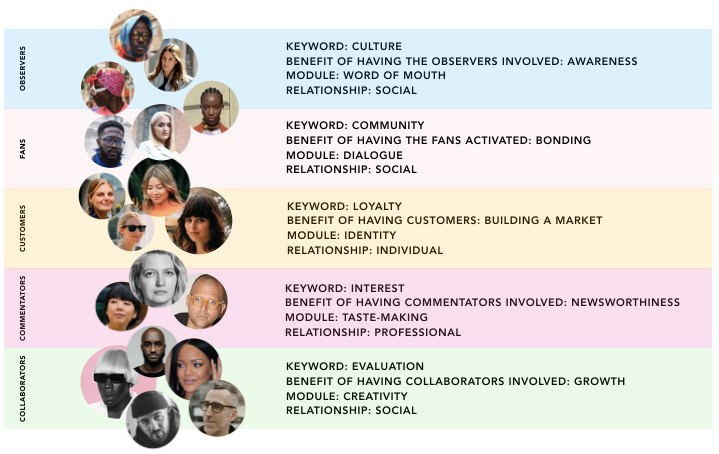I received cultural theorist
’s excellent new zine on audience capture the other day...Audience capture is the proposed phenomenon where an online creator gets shaped by chasing their audience's approval, and their personality contorts in ways that pull them out of their integrity. The canonical example of audience capture comes from
, discussing how internet celebrity Nicholas Perry went from skinny vegan to obese "mukbang" eater because he chased approval from his audience, who cruelly encouraged him to keep eating.
Audience capture is often written as an existential given. I do not think it is. My philosophical hot take is this: audience capture is an illusion—a useful one, pointing to what is really happening for those who want to look. My questions to challenge this concept are twofold:
Firstly, who is the “audience”?
Secondly, who is being “captured”?
My responses to these are radical, as are my recommendations.
WHO IS THE “AUDIENCE”?
For the past five years, I have had an online persona, which sociologist Sherry Turkle calls a "second self." A second self consists of all one’s activities online: Twitter profile, Substack newsletter, YouTube channel, etc.
Throughout my second selfing journey, I never liked seeing my online activities through the prism of my audience. Knowing your audience is often the first advice given in any how-to course on how to build a “successful” online brand. I never really knew who or what my audience consisted of. What does an audience even mean?
From the literature I’ve read on online audiences, the best I have encountered is brand executive
's “audience” taxonomy:
I have found Andjelic's audience taxonomy remarkably accurate. I do not relate to these audience categories the same way. My observers are not necessarily my fans; while my fans are often my customers, not all of my customers are my fans. My commentators (or critics) are usually neither fans nor customers; my collaborators seem to weave between all these categories.
I appreciate this taxonomy as it enables me to understand better my interactions with those who engage with my second self, enhancing my overall sense of how I relate to them. Each kind of audience influences me differently, and I attempt to influence them back. I have developed social protocols for relating to each category more consciously. However, when people refer to audience capture, none of these categories are what people are being “captured” by.
Sociologist George Herbert Mead wrote about the "generalized other," sometimes called an "imagined audience." This audience is one that individuals believe to be real, representing their sense of society's expectations of them. This sense shapes an individual's behavior and sense of self, which reflects their imagined community's shared values and beliefs.
The imagined audience is an intersubjective spell being cast, and while illusionary, it is real enough to influence a world. This is a hard spell to break because some expectations are real. If these expectations are unmet, real social consequences can occur—rejection, criticism, cancellation, etc. However, the imagined audience is in your head rather than your audience, and many expectations are no longer present or once were but now are outdated, needing to be released and ready for renegotiation.
“Imagined audience capture” is the real phenomenon here. People are captured by the imagined expectations of their real audience. Many not only jumble up all the categories in Andjelic’s taxonomy as one thing but also project unexamined imagined audiences on their real audience, bringing along imprisoning expectations.
Building a conscious relationship with each facet of one's real audience is wise; building a conscious relationship first with the imagined audience cast in our mind is wiser.
Recommendation
To break the spell, adopt a practice to consciously relate with your imagined audience, to know its contours, tease out its demanding expectations, and negotiate with them. Most of their expectations can be ignored, not needing to be met. After all, at the bottom of being pulled by these expectations is a fear of not being understood, approved, or loved. Address the gaping hole at the core first.
"Active imagination" is a great way to dialogue with one's imagined audience and touch what's at the core. An embodied journaling practice allows one to converse with the imaginal in an actively therapeutic way. Once this conversation begins, a greater sense of how complex a real audience is will soon follow.
Imagined audience capture happens to everyone, not only those with a second self. The good thing about having a second self is that it can allow this phenomenon to become more easily conscious, giving greater agency to commune with one’s real audience.
Second selfing is the practice of developing greater communal agency.
WHO IS BEING “CAPTURED”?
Those interested in audience capture should acquaint themselves with the phenomena of “supernormal stimulus.” This refers to an exaggerated artificial version of a stimulus that elicits a stronger response compared to the naturally evolved stimulus it mimics. Some examples of supernormal stimuli for humans are junk food, video games, laugh tracks, and porn. The latter is because exaggerated sexual situations surpass the intensity and novelty of real-life sexual encounters.

Creators today create their second self to be a supernormal stimulus. They create exaggerated avatars of themselves that are more confident, interesting, and exciting than their real self. They create a second self that is too hot to look away from, to capture attention, to capture you. I'm not fond of the one-way framing of the audience's capture dialogue. The creator is not being captured by their audience; they are trying to capture their audience.
Sometimes this capturing is explicitly driven by the profit motive: win in the attention economy, win in the market economy. Other times, it is done unconsciously due to copying others (aka "mimetic desire"), narcissistic ego-validation, or plugging up the gaping hole at the core with the neverending hunt for likes. Quite often, it is a mixture of both.
Attracting an audience into a trap is one thing, but keeping them there is another. An unconscious bargain is made to keep their audience trapped. The captor will not only make their avatar into a supernormal stimulus but also superficially more understandable, acceptable, and loveable to those they are attempting to keep captured. This juncture is when the captor feels like the captee. This juncture is when the creator supposedly loses their integrity.
The current framing of audience capture is that a creator creates, then gets captured by their audience, losing their artistic integrity. This view is mistaken. The creator loses their artistic integrity when creating their second self unartfully.
Recommendation
A realization is required to avoid capturing and being captured by an audience: your primary online relationship when having a second self is not an audience, real or imagined. The primary relationship you have online is with your second self. Most people do not have a good relationship with their second self; they are enmeshed with it. They create and relate with their second self as if it were their real self. This is not the case.
To maintain artistic integrity, creators must create their second selves as a work of art. Create a beautiful second self, then allow its beauty to create you. In an act of radical solipsism, fall in love with your second self. Write to your self and no one else, and approach these love letters as a work of art.
If this is done well enough, chances are that those who share your sense of beauty will be attracted to your second self, wanting to commune around it without the hidden coercion or manipulation that comes with the supernormal stimulus approach. Create your second self beautifully enough, and then the right people will come into your life, making life more beautiful.
Second selfing is the practice of finding "the others."
***
Audience capture is a real phenomenon. However, it is presented in a way that only partially captures what is really happening.
We feel like we are getting captured when we are the ones doing the capturing, and what we are trying to capture is our illusions being projected on others, who are trying to capture their own illusions. The current online game is piling illusory bullshit upon heaps of illusory bullshit.
However, this bullshit game can be seen as good because we only feel captured by the illusions we need a lesson from. "They" will not release us until that lesson is received. The proper response to audience capture is audience release. When captured, something needs to be released. That something is subtle: a false belief, a rigid expectation, an unfair demand upon reality.
The primary illusions to release:
Your imagined audience is not your real audience.
You are not your second self.
Once these illusions are let go, greater agency to commune with others will emerge, along with artfully creating a beacon to find the others to commune with. Audience capture is not a bug, but a feature, of the new worlds we are creating together. It is an opportunity for the practice of audience release, and the more that is released, the more clarity arrives about what is really going on here.
In future entries, I will elaborate on the second-selfing art form in theory and practice. Feel free to stress test or elaborate on the theory and recommend your practices in the comments.


